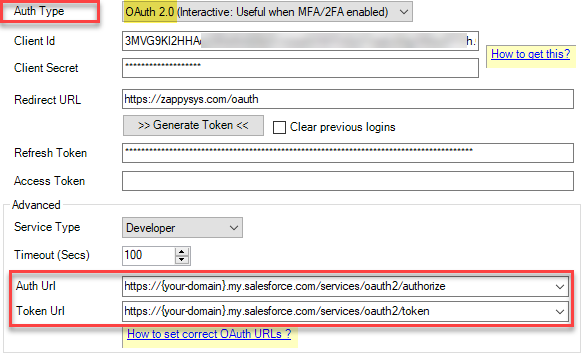Salesforce OAuth URL Selection Guide
If you are using ZappySys Salesforce ODBC Driver or SSIS Salesforce Source or Destination, choosing the correct OAuth /authorize and /token URL is critical for authentication. The domain you use must match the domain your Salesforce org uses when you log into the browser.
Example of ZappySys Salesforce Connection UI
Recommended URL Format (Use This Whenever Possible)
https://<your-domain>.my.salesforce.com/services/oauth2/authorize
https://<your-domain>.my.salesforce.com/services/oauth2/token
Works for:
- Production
- Developer Edition
- Free Trial / Playground
- Most orgs with My Domain enabled
How to Find Your Correct Domain
- Log in to Salesforce in a browser
- Look at the URL in the address bar
- Use that base domain in your OAuth URLs
Example:
Browser URL:
https://zappysys5-dev-ed.develop.my.salesforce.com/...
Use:
https://zappysys5-dev-ed.develop.my.salesforce.com/services/oauth2/authorize
https://zappysys5-dev-ed.develop.my.salesforce.com/services/oauth2/token
Valid URL Variations You May See
Standard My Domain (most common)
https://<domain>.my.salesforce.com/services/oauth2/token
New Developer Edition cluster
https://<domain>.develop.my.salesforce.com/services/oauth2/token
Legacy Lightning UI domain
https://<domain>.lightning.force.com/services/oauth2/token
Global login for Production
https://login.salesforce.com/services/oauth2/token
Global login for Sandbox
https://test.salesforce.com/services/oauth2/token
DO NOT Hardcode These (Will Break)
![]() Using instance URLs like https://na85.salesforce.com
Using instance URLs like https://na85.salesforce.com
![]() Assuming all orgs behave the same
Assuming all orgs behave the same
Quick Rule of Thumb
Use the same domain you see in your browser after login, then append:
/services/oauth2/authorize
/services/oauth2/token
This guarantees correct routing for your Salesforce org.
Optional: Automatic Endpoint Discovery
Advanced users can dynamically discover the OAuth endpoints:
GET https://<domain>/.well-known/openid-configuration
This returns authorization_endpoint, token_endpoint, and more.

